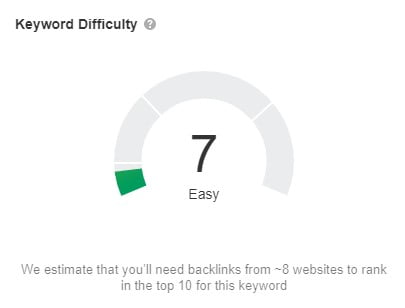You’ve been told that SEO is a long haul. A slow grind to the top. A meticulous craft that takes months of work before you see results.
And in many senses, that’s true.
But that doesn’t mean there aren’t fast, simple ways to boost your rankings. That’s what I’m going to show you how to do today.
First-page rankings may be a few tweaks away. Low-hanging fruit refers to a quick win that has an immediate effect on your site. By completing these simple tasks, you’ll see a substantial impact on your search engine rankings.

SEO low hanging fruit keywords are great if you’re on a budget; you don’t need to spend a fortune on search engine optimization to see results. Take advantage of these opportunities to:
- Boost your average click-through rate
- Lower your bounce rate
- Get more traffic by ranking higher for your target keywords
These SEO quick fixes are ripe for the picking. Let’s dive into it:

Low-Hanging Fruit Keywords
You’ve put hours into keyword research, hand-picking the search terms you believe will generate the most traffic.
But even after all that work, there might be a few easy wins right under your nose!
What we’re looking for are keywords that you for rank on the second page. If your website is just shy of ranking on the first page, your rankings will soar with a few tweaks.
If you’re ranking on page 2, it means that search engine crawlers know your website is relevant—just not enough to put you on the first page.
We can fix that!
So, how do you find low-hanging fruit keywords? We’re going to start by finding long-tail keywords. They’re less competitive than short-tail keywords but still get enough search volume to make your efforts worthwhile.
Your competitors will typically overlook these keywords while you sit back and rake in the extra traffic.
To start, you can use any rank tracker that you prefer. I’m going to use Google Search Console; it’s free to use and easy to set up on any website.
If you haven’t already set up your website with Google Search Console, do so now. Then, navigate to the Performance section on the sidebar. Click on the page you want to work on.
When you hit the Queries tab, you can see all the keywords people use to find your content.
You’re going to pick out keywords that rank either at the bottom of page 1 or somewhere on page 2.
Once you’ve collected a list of those keywords, it’s time to narrow it down. You want to focus your efforts on keywords that generate the most conversions. Start by asking:
- What is the search intent behind this keyword? SEO isn’t just about ranking better in search engines. It’s about providing a satisfying experience for users. When people search your chosen keyword, will your content be helpful to them? And will it generate more conversions for your website?
- Can I tweak my website to rank for this keyword? Is the page you’re working on a good fit for this keyword? And if it’s not, is there a new page you can create to make your site more relevant for that search query?
- How much organic traffic will this keyword generate? If you’re going to optimize your website for a keyword, you want to make sure that your efforts will pay off. Take note of how much search volume your search term gets. Will it make a difference to your website? Numbers are all relative to the current traffic your website gets, so use your best judgment.
And finally, one last tip about conversions. Let’s say you’re choosing between two low-hanging fruit keywords: “pros and cons of dental veneers” and “cosmetic dentist near me”.
If your website is about dentistry, both of those terms will be relevant to you. But which will generate more conversions?
The first keyword is informational (the user wants to learn more about veneers), while the second is transactional (the user is ready to book an appointment).
If you want more conversions, you’re better off focusing on the second keyword. Concentrate your efforts on transactional keywords to make more sales and boost your search engine rankings.
On-Page Low Hanging Fruit
Now that I’ve covered how to find low-hanging keywords, it’s time to implement them on the web pages on your site, from your alt tags to your internal linking structure.
It might sound complicated at first. But remember, these are easy wins, and they’re worth the effort. With just a bit of work, your rankings will start to grow.
Let’s start by working those low-hanging fruit keywords into your website:

Title Tags
Google doesn’t know what your website is about unless you tell it.
How do you do that?
By putting your target keywords in all the places Google checks. One of those places is your title tags.
A title tag appears on search engine result pages; it’s the blue text you see above each result. It’s also what appears at the top of your browser tab. Google looks at title tags to find out what your website is all about.
Title tags have a limit of 50-60 characters. Try to fit one of the keywords you found earlier into your title tag. But don’t force it—only include the keyword if it’s relevant to the content on the page.
Meta Descriptions
First of all: Does your website have meta descriptions? These ~155 character descriptions are a concise summary of your page content. If you haven’t written any for the pages on your site, now’s the time!
Meta descriptions give you another opportunity to add a low-hanging fruit keyword. Try to fit one naturally within the description. You can also learn how long it takes for Google to update your meta descriptions here.
H1s
Your H1s are what introduce your content to your reader; they’re like headlines but for your online content.
H1s appear on the web page itself. They set up the reader’s expectations and tell them whether your content will answer their question.
Sometimes, your H1s will be the same as your title tags. But not always. You may want to use one title tag to boost your click-through rate in SERPs and a different H1 to keep readers on the page.
Regardless, you should always try to fit a keyword in your H1. Always keep search intent in mind. How can you include a keyword while still addressing the reader’s main questions?

Low Content Pages
It’s time to tweak and prune low-quality pages. If your content isn’t driving more organic traffic to your website, it’s on the chopping block.
Most of the time, the pages that get the least traffic are also the ones with the thinnest content. In SEO, the more content you have, the merrier.
If you look at correlations between word count and rankings, you’ll see that long content consistently ranks higher than short content.
Can you go back and add more words to an existing post? Try to add a few low-hanging fruit keywords if it makes sense.
But it’s not as simple as stuffing your pages with fluff. The reason why longer pieces rank better is that they go more in-depth (and cover more entities) than shorter ones. They’re also more likely to get backlinks from other sites.
So, in summary: You should write as much content as your topic calls for. Create a well-researched and insightful post about your subject. And for reference, you can look at the length of other highly-ranked blog posts on the topic.
Image Optimization
Up until now, we’ve focused on editing the content on your website: The title tags, body paragraphs, and the H1s.
Now, we’re going to go over your images with a fine-toothed comb. You can optimize images in a few ways, all of which are easy to do:
- Compress them. Are your images bloated? If they’re bigger than they need to be, they’ll drastically slow down your site speed. Here’s a quick fix: Compress them! You’ll only sacrifice a bit of quality for much faster loading times. There are a ton of free tools online that compress images for you. You should aim for a max size of 250kb per image.
- Add alt text. Add descriptions of your images for those with visual impairments. Google uses alt text to understand your images, so it’s another way to help bots understand your content.
- Reformat and resize them. Make sure your images are the right size and format for your website. A great format for images are .webp.
- Geotag them. If you're running a local business, you'll want to make sure your images are geo-tagged. This process simple adds extra exif data to your image which include the coordinates of where the image was taken. Even if you're using a stock photo for the hero section on your homepage, it's great to geo-tag it. You can use this free geo-tagging tool here.
Internal Linking
Internal links point search engine crawlers to other pages on your website. They help the content across your website get crawled.
Without internal links, certain pages on your site may become orphaned. You can’t hope to rank for your target search terms if Google’s bots can’t find those pages. Help them out by linking to them in your blog posts and on your service pages.
Internal links also keep users on your website, pointing them to other pages that may be of interest to them.
Whenever you drop an internal link into your content, pair it with descriptive anchor text. Ideally, you could include one of your keywords in that anchor text. The anchor text provides context to Google's crawler about which page it's about to encounter when it follows a link.
Find SEO Low-Hanging Fruits With My Consulting Services
Implement these quick fixes, and watch your rankings climb from the bottom of page 2 to the top of page 1!
Need help finding some quick wins for your website? At SerpFocus, I’m entirely focused on leveraging the power of SEO to improve your rankings and boost your sales. With my SEO consulting services, I’ll help you discover how these easy wins can transform your website. If you're not quite ready for that, read my post on how to find low hanging fruit for quick SEO wins here.



Leave a Reply
You must be logged in to post a comment.